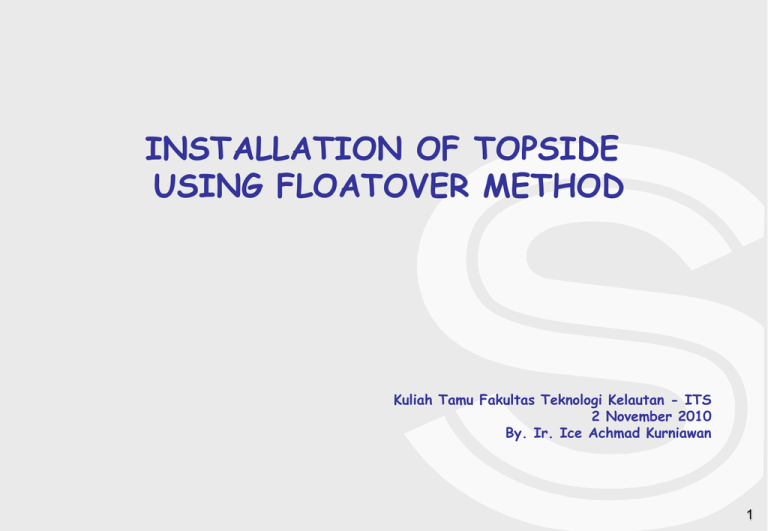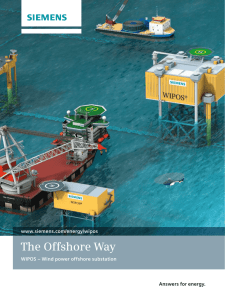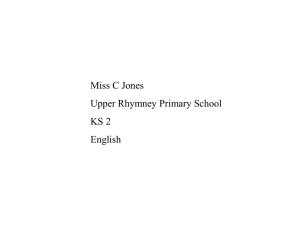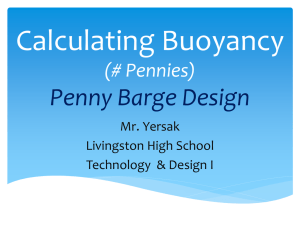Diapositiva 1 - WordPress.com
advertisement

INSTALLATION OF TOPSIDE USING FLOATOVER METHOD Kuliah Tamu Fakultas Teknologi Kelautan - ITS 2 November 2010 By. Ir. Ice Achmad Kurniawan 1 Agenda 1.Why Floatover 2.Floatover Concept 3.Design Engineering 4.Barge Equipment and Appurtenances 5.Floatover Sequences 6. Procurement 7. Marine Spread 2 1. WHY FLOATOVER Conventional method: LIFTING WHY FLOATOVER - Unavailability of suitable vessel with crane capability to install heavy topside (>2000MT) - Cost and schedule advantages of installing precommissioned, integrated, single-piece topsides. - Desire to reduce increasingly expensive offshore hook-up and commissioning time - Now more demanding due to Scarce availability of heavy-lift crane vessels for work in shallow waters 3 2. FLOATOVER CONCEPT - The topside module typically is placed on a barge or heavy transport vessel positioned within (internal slot of jacket) or around the legs (external) of a pre-installed jacket - The module then is settled onto the jacket legs by a combination of vessel ballasting and a mechanical lowering system. - The operation of incrementally transferring the module loads from the barge to the jacket (MATING operation) - Undocking, sufficient clearance, vessel move out from the jacket 4 3. FLOATOVER T&I DESIGN ENGINEERING 1. Deck Mating analysis 2. Barge Strength Check (load out & transportation condition) 3. Transportation Analysis 4. Mooring Analysis 5. Seafastening Design 6. Floatover Rapid Ballast System Design 7. Jacket Structural Analysis (allowable limit during floatover) 5 PROCESS DESIGN FLOW DIAGRAM 6 MATING ANALYSIS •To simulate the barge’s motion characteristic and to identify the loading on the jacket using a time domain analysis. •Multiple load cases were identified from the initial stage, docking, load transfer and undocking stage to represent the floatover method •The load impact result shall be within allowable jacket design load •Installation sea states criteria shall be established at up front stage as an input for the analysis. •Software use MOSES or LIFSIM Seastate Input (Installation Criteria) Head/stern sea Hs = 1.00 m Tz up to 7.5 s Quartering sea Hs = 0.75 m Tz up to 7.5 s Beam sea Hs = 0.50 m Tz up to 7.5 s Output will be used to determine the flaotover workability 7 DSF-BARGE SEAFASTENING 8 TOPSIDE-DSF SEAFASTENING 9 LMU 10 DSU 11 PLAN LAYOUT LOAD OUT 12 LAY OUT FENDERING SYSTEM 13 JACKET ALLOWABLE IMPACT LOAD 14 4. FLOATOVER OPT.SEQUENCES • • • • • • • Standby - The vessel is a safe distance from the substructure but connected to the mooring system, preparation rapid ballast system or the hydraulic jacks are under way Docking - The vessel enters the substructure and alignment Pre-Mating - When ballasting the vessel to match the leg mating units (LMU) with receptors on top of the substructure legs and removing the remaining tie downs, it is critical that the vessel motions be limited to suit the chosen LMU geometry. No weight transfer yet occurs Mating - The topsides is lowered onto the substructure by either rapid ballasting of the vessel or by contracting the hydraulic jacks. The topsides weight is transferred to the jacket completely Post-mating - A gap is created between the deck support units (DSU) and the vessel to ensure vessel motions will not cause contact between the two Exit - The vessel is removed from the jacket slot. Post Floatover - Removal of premooring system, clean up installation aids from jacket if required - Process of welding & NDT examination between topside leg with jacket transition pieces - Final Survey 15 ANCHOR PATTERN 16 ELEVATION 17 5. BARGE SYSTEM AND APPURTUNANCES 1. Rapid Ballast System: to perform the load transfer in the available 12hour tidal sequence, with specific rate. Can be external or internal (modified from existing barge ballast system) 2. Fendering system was designed to ease the transition through the jacket with sufficient clearances, which reduced the sway impact loading upon docking. 3. The surge fenders were installed to lock the barge in its final docking position. 4. LMU (elastomer-based leg mating unit): to reduce the vertical impact forces (designed to support 50%) of the deck load during load transfer. 5. DSU (Deck Support Unit), elastomer to reduce vertical impact between DSF and topside during the deck load transfer 6. DSF (Deck Support Frame), structure to support topside during load out, transportation and floatover 7. Barge Motion Monitoring System, electronic system to monitor motion of the barge (6 degree of freedom, the motion will be compared with mating analysis) 8. Positioning System 9. Wave Rider Buoys 18 BARGE GENERAL LAYOUT 19 6. PROCUREMENTS 1. S45 PREPARATION AND FENDERING SYSTEM 2. LINKBEAMs & LIGHT SKIDBEAMs FABRICATION 3. 3RD PARTY MARINE SPREADS CHARTER (Various) 4. EXTERNAL RAPID BALLAST SYSTEM 5. SURVEY AND POSITIONING 6. WEATHER FORECAST 7. CATERING SERVICE 8. INSTALLATION AIDS 9. VSAT LINK SERVICE 10. AGENCY SERVICE 11.ROV 13. NDT 7. MARINE SPREAD 1.1 X TRANSPORTATION BARGE (S45) 2.1 X TOWING TUG 14,200BHP 3.2 X AHT 10,800BHP C/W KARMFORKS 4.1 X AHT 7000BHP 5.1 X AWB (Accommodation Work Barge), 120PAX CAPACITY, 120T CRANE 6.1 X CREW BOAT, 80 PAX CAPACITY 7.1 X ZODIAC BOAT 1.Project Description NORTH BELUT WHP-C CPP Topside MALAYSIA DUYONG 22" x 10 km INDONESIA WHP-D gas phase - 16" x 37 km liquid phase - 12" x 37 km 18" x 100 km ADGF PLEM HIU SUBSEA KERISI PLEM 24" x 93 km gas phase - 16" x 23 km liquid phase - 12" x 23 km 16" x 0.5 km CPP BELANAK FPSO/ FSO WHP-K KERISI The NBCPP topside is a large, complex integrated deck with a not to exceed weight of 14,000 MT. The field is located approximately 60km east-north-east of the Belanak FPSO installed in the Belanak Field, located on the Block B of the Indonesian sector of the Natuna Field. 22 2.Project Phases Load out of CPP Topside on S45 Location: S45 mobilize to Topside Fabrication Yard Transportation of CPP Topside Sailaway Location: Block B of Natuna Sea – Indonesia Installation of CPP Topside using Floatover method on CPP Jacket The NBCPP is located in 95.2 m water depth 23 3. Scope of Work Main Scope of Work: • Provision of expertise, manpower, plant, equipment, Contractor’s Spread, consumables and all other items necessary to transport CPP Topside components from the fabrication yard to the North Belut offshore Site and install them safely and efficiently. 24 4.Project Key Milestones Date Activity 11 June 2007 Contract Effective Date 3 Jan 2009 S45 transfer to Sintai for Fendering System and Preparation Work 1 May 2009 S45 mobilized to PTMI Yard 16 May 2009 CPP Topside loaded out onto S45 barge 1st June 2009 Sailaway of CPP Topside 6th June 2009 CPP Topside Installed using Floatover method 7th June 2009 All vessels demobilized from site 25 5.Interfaces with Other Company’s Contractor No Description PT Technip PT Mc Dermot PT Saipem X Review + supply barge data, check barge strength and stability for load out 1 All loadout planning, engineering and AFC dwg 2 Load out operation 3 Structural Load out Analysis (Reaction load) X R 4 Transportaton Analysis R X 5 Mating Analysis R X 6 Installation Aids fixed by welding to jacket structures 7 DSF R X R Supply material, Fabricate and pre install Design and supply AFC dwg and MTO Design Supply material, Fabricate R 8 CPP Topside Design Supply material, Fabricate 9 LMU (OKI) Design, Fabricate Install 10 Seafastening R Supply material, Fabricate and install Design and supply AFC dwg and MTO R R, may request to use assistance Design and install 11 External Rapid Ballast System Floatover R = Review X = Responsibility Project Photos LOAD OUT Project Photos TOWING Project Photos PRE-MATING Project Photos FLOATOVER Project Photos FLOATOVER Project Photos FLOATOVER Project Photos FLOATOVER Project Photos FLOATOVER Project Photos FLOATOVER Project Photos FLOATOVER







